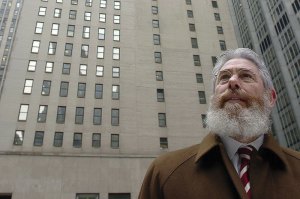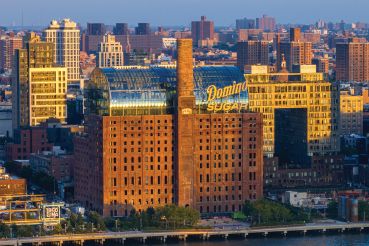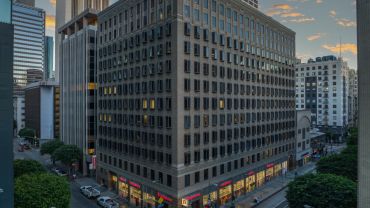The Mogul, Lost and Found: Developer Shaya Boymelgreen in the City of Second Acts
By Dana Rubinstein July 13, 2010 9:24 pm
reprints
The breakneck rise and fall of New York developer Shaya Boymelgreen unfolds like a Gilded Age novel of social ascendance: young man immigrates to ethnic neighborhood in big city; accidentally takes part in Crown Heights riot of historic importance; strikes up fortuitous friendship with Uzbek diamond billionaire who agrees to bankroll his projects; gambles on some of boom era’s most talked about and coveted developments; and then, as quickly as he rises, disappears, lawsuits and angry creditors chasing his wake.
‘If I cannot make it in Manhattan, I don’t know where else I can make it.’
New York City real estate has a blessedly short memory. It’s a truism in the industry that once a man makes his mark, earns his stripes and cements his relationships, even the most famously disastrous business decisions cannot permanently tarnish his name. Think Jerry Speyer. Harry Macklowe. Donald Trump. All men who have seen tremendous triumphs, tremendous declines, then triumphs all over again. That list of comeback kids may soon include Shaya Boymelgreen.
“I’m back in town,” Mr. Boymelgreen told The Observer on July 12, in what he said was his first interview with a reporter in three years. He was phoning from a 646 number that did not accept incoming calls.
Not only is Mr. Boymelgreen back in town—he is back in business. The Lubavitcher developer has leased an office in a midrange skyscraper on Broad Street. And he is scouting New York for new development opportunities.
“We have a few, I would say, institutions and private institutions behind us, from the U.S. and Israel,” Mr. Boymelgreen said, in heavily accented English. “Unless I get an offer I can’t refuse, I would like to concentrate now in Manhattan. I believe this is now the opportunity and the time. If I cannot make it in Manhattan, I don’t know where else I can make it.”
SHAYA BOYMELGREEN HAS has made it in Manhattan before. After immigrating to Brooklyn from Israel in 1969, he settled into a stately red-brick row house on President Street in Crown Heights. He got into the Judaica business, the diamond business and asbestos removal. Then, on Aug. 19, 1991, while driving near the intersection of President and Brooklyn Avenue, he happened upon a pivotal moment in New York City history: From his car, he saw an injured young man struggling to walk down the street. The man was 29-year-old Yankel Rosenbaum, who just minutes before had been stabbed and beaten in the Crown Heights riots. Mr. Boymelgreen cradled him until an ambulance whisked Rosenbaum to the hospital, where he died. “He held my hand and said, ‘I’m scared, I’m scared,'” Mr. Boymelgreen told The New York Times in 2005.
In 1994, Mr. Boymelgreen founded Boymelgreen Developers. He built his first apartment house on Avenue A and Third Street. In 2002, he completed a conversion of an old Daily News printing plant into a condo called Newswalk, one of the first in the Prospect Heights area. That same year, Mr. Boymelgreen formed a partnership with Uzbek diamond billionaire Lev Leviev, whom he met on a kosher cruise. With Mr. Leviev’s cash, Mr. Boymelgreen positioned himself at the forefront of the redevelopment of Lower Manhattan’s obsolete office stock into residences, part of a hoped-for transformation of the business district into a 24-7 community.
“I found him to be a visionary,” recalls James Kuhn, the president of brokerage Newmark (NMRK) Knight Frank. Together with his colleague Alice DiMarzio, Mr. Kuhn sold Mr. Boymelgreen three downtown office towers.
“He came to us and he said JPMorgan Chase was selling 15 Broad Street,” Mr. Kuhn recalled. “He wanted to buy it and he wanted our help, because he wasn’t known and he didn’t have any credibility. So we met him there, with Lev Leviev. We called up JPMorgan Chase. They already had two contracts out, both in the $85 million range. We talked to Shaya, and we suggested if he thought it was the right deal, he should bid $100 million. And that was the start of Shaya Boymelgreen’s adventures in Manhattan.”
They redeveloped the century-old office building at 15 Broad into high-end condos, with designer Philippe Starck. In a tacit acknowledgment that the neighborhood still lacked Manhattan conveniences, it came with a small town’s worth of amenities: bowling alley, yoga studio, children’s playroom, basketball court, business center. They followed a similar concept at 20 Pine, this time with marketing wunderkind Michael Shvo creating New York’s first 24-hour residential sales office and Giorgio Armani’s firm designing the interiors. In Tribeca, at the corner of Laight and Washington streets, Messrs. Leviev and Boymelgreen converted an old warehouse into the River Lofts condo, attracting the likes of Meryl Streep and Gwyneth Paltrow.
What more in life does a man need? Eight children, a lovely home, a real estate business that soon stretched to Miami and Houston and Israel, a staff numbering more than 200? His own bank, perhaps? In 2005, Mr. Boymelgreen founded LibertyPointe, a commercial bank catering to the Orthodox Jewish community. The launch party, in the Lower Manhattan branch, ended with a sit-down feast at a long table laden with fine food and drink, and presided over by the founder.
MR. BOYMELGREEN, 59, has a charm so ingratiating and a beard so cloud-white that he could land a second gig working the Santa Claus line at Macy’s. Yet beneath the charm lies a shrewd businessman who, his critics allege in court papers and in the press, is less than forthcoming with his lenders, business partners and clients, and who, either because he wants to save money or doesn’t have the requisite expertise, has built projects with serious construction flaws.
“He’s a really friendly, warm guy,” chuckled Michael Rogers, who bought a three-bedroom condo in Newswalk in 2002, and whose condo board is now suing Mr. Boymelgreen for at least $10 million in damages for shoddy construction, including leaks that have damaged 70 of the 173 units. The board has since launched a $7 million capital campaign to correct the construction errors and built a Web site, shameonshaya.org—in English, Russian and Hebrew—featuring videos depicting their living conditions. Jazz electric bassist Richard Bona is featured in one such video, sitting in his top-floor apartment so inundated with leaks that he called it a “Jacuzzi.”
“My wife is sleeping at her uncle’s place,” said Mr. Bona, some of whose instruments have been damaged by the flooding. “The whole balance of my life is kind of messed up, because you can’t have a life here.”
In response to the Newswalk controversy, Mr. Boymelgreen said, “Everyone has a problem with something. You know how long ago we finished and fixed and corrected Newswalk?
“It’s become a trend that every condominium, either they sue or they’re going to sue because the lawyers that don’t have much to do these days are running after the condo board and saying, ‘Let’s make some money,'” Mr. Boymelgreen added. “For me and for everyone else, it is a problem.”
Newswalk is hardly the only pebble in Mr. Boymelgreen’s shoe. He publicly fell out with Mr. Leviev in the summer of 2007, prompting the dissolution of their partnership. In 2009, residents of both River Lofts and 15 Broad filed preliminary summonses against him and co-defendants in Manhattan Supreme Court, citing construction flaws. Aristone, the group that helped him finance the purchase of a prime plot of land along the High Line, at 500 West 23rd Street (also known as 10 Chelsea), sued Mr. Boymelgreen in December, accusing him of selling the land behind its back and trying to spirit away the proceeds without repaying his creditors.


